Making a Story Visual UPDATE: Behind the Scenes of the Animal Eye Comic
Whenever I deal with science fiction, fantasy, or horror written by Christians or for Christians, I am struck by how the potential audience for this type of story is much bigger than what authors are currently reaching. This post, while serving a dual purpose to promote a specific project, most importantly explains why the Animal Eye comic exists and how it’s part of the drive I feel to reach a larger audience via visual media. (IF YOU’VE ALREADY SEEN this article, look down to the bottom for some updated information. If you haven’t seen this before, enjoy!)
In that sense the Animal Eye comic is an example or model and I hope it will be part of a full arc of a successful crossing over into other media. I also hope this article will help other story creators decide if comics are a good choice for them—and further, may this bit of written work will help fans of Christian fiction become aware of a medium (comics) that they may not be paying much attention to.
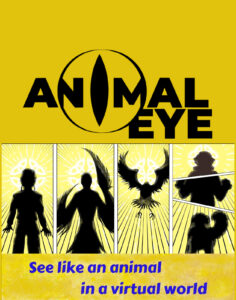
The Animal Eye logo and art showing the human players become animals. Based on artwork by Rowell Cruz.
The Dominance of Motion Pictures–and Moving that Direction
Informal surveys I’ve done on churches I’ve attended yield no shortage of fans of speculative fiction, especially the space opera flavor of science fiction and also epic fantasy. But these genres are mostly enjoyed by a majority of people in movie form. If we throw superhero movies into the mix, I’d guess that well over fifty percent of almost any group of Christians enjoys speculative stories–but only a tiny fraction of them are reading the stories in novel or short story form. Most are watching movies. Some read comics in addition to movies. Another group plays video games and also watches movies. Only a relative few are mainly readers of fiction–but even the reader crowd also watches movies.
So for that reason I’ve thought, for around six or seven years or so, that Christian creators should be getting into filmmaking. However, that’s significantly easier said than done.
I can pull an example of what I mean from my foray into translating stories from English into foreign languages. Hey, that’s something I’m already partially proficient at, because I speak multiple foreign languages (especially Spanish and French) and have actually worked as a translator. But even so, knowing part of what it takes and “translating that” into a business model of regularly-produced stories in foreign languages has proven to be quite difficult for me to pull off. Yeah, I’m still moving forward on getting speculative fiction stories into Spanish, French, and Portuguese (with other languages planned), but it’s hard, harder than you might think, to do it right. And that’s a subject I know.
Making movies I don’t know much about. So naturally there’s no easy way for me to immediately step into movie-making. That is, people like me without the proper training and equipment can’t just make it happen on a whim. Not to mention the budget for special effects and digital art.
So for me, comics are a step in that direction.
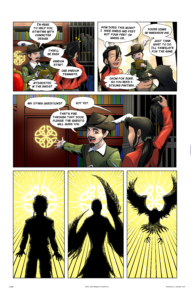
Page 2 shows the human player Khin May becoming Ahva the Crow. Would make an interesting scene in a movie!
I don’t want to sell comics short, like they are only a means to an end. They aren’t–however, I suggested to Cindy Koepp we make her Novel Animal Eye into a comic because I want to head in the direction of more visual art. Ultimately I want to get to the production of films. I’m hoping Animal Eye is a good candidate for going in the direction of more visual media.
Drawn by the Idea
The most important thing about the Animal Eye story is it’s in a genre known as GameLit. The story is set within a video game. (Cindy Koepp and I did an entire blog post about GameLit as an original approach Christian writers could take to speculative fiction and talked about a few details behind the Animal Eye story as well in a previous post for Speculative Faith.) For the purposes of this post, the plot of Animal Eye isn’t that significant–what is significant is the story has a natural connection to visual media.
The story features human beings with the ability to see and do things the way animals would–or better said, the they can see and to the way very-realistically-simulated animals would (as seen by human video game players). For example, the story-set-in-a-video-game describes a dog character seeing words rise from things revealing scents. Such scents could blow in the wind or linger on things like clothing. Which would be a simulated way to perceive the world the way a dog does. Which would bring with it with the drawback of not seeing in as many colors as a human can see—again, as much as possible, showing the world the way a dog experiences it.
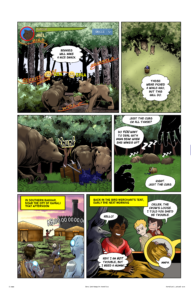
Page 11, scent words rise in the top left panel as Jael the bear not only sees but smells the world around her.
Another example: A bird would be able to see further and clearer than a human–and from an aerial perspective of course. Likewise a cat character could see at night. Animals in general in the Animal Eye story world can perceive human emotions by smell and other clues a human would not detect, even if the person is trying to hide their true feelings. (Which in the story world is shown by emojis floating over human characters.)
Seeing what the animals can see is an inherently cool idea, I thought. What a shame that the medium of written words can only tell what that would be like but cannot show it, I thought.
Entering Into Comics
Cindy, the author of Animal Eye, happened to have befriended a Christian creator of comic books around the time I published Animal Eye in novel form…and when she was filling in for me here on Speculative Faith on one occasion, she wrote an article about that company (Terraform) and their comics. Shortly after that, I asked her if she’d be interested in making her novel into a comic. Because wouldn’t it be nice to actually show the (simulated) animal perspective the novel described.
She agreed it was a good idea. So we set off in pursuit of that goal. Making the novel Animal Eye into a comic.
How to Make a Novel into a Comic–According to an Idiot Who Had Never Done It Before
Well, calling myself an “idiot” may be going a bit far (though not everyone reading this will disagree I’m sure, lol), but in fact I knew very little about comic books. I barely read comics. How do you go from not knowing anything to making a nice-looking final product? Let me detail my method:
- Have somebody else do the scripting OR be willing to diligently study how to write a comic book script: Quite honestly, Cindy did the scripting, though maybe I should have, since it was my idea. She also worked at understanding how a comic book script works (in short, you’ve gotta be brief and action-oriented). She asked people about it. She studied. She practiced.
Her research materials included Scott McCloud’s trilogy: Reinventing Comics, Making Comics, Understanding Comics; and some sample scripts supplied by comic book writer and novelist Brian K. Morris. It took time and effort. THEN, she asked my idiot self what I thought about her script for issue and I managed to stammer out a few words about inconsistencies I noted in the story, gave some ideas guiding the best approach to take in certain scenes, and looked for spelling errors. But let’s be clear–while I helped with the comic book script for Animal Eye, Cindy Koepp did the heavy lifting.
- Make friends in the genre: Maybe I should have listed this as step one, because it affects so many other steps here. Friends in the comic genre have helped us with advice on scripting, art, promotion, distribution, and many other things. However, you could learn to write a script without having any friends who are into comics if you referenced the right resources. So you could in fact start the script first. But you will need friends to help with other things. Cindy paid attention to comic book writer friends, messaged groups of authors, offered corny jokes, gave support to people and in many ways, by being friendly, got the help and advice she needed. (I also contributed a small bit here–I know a guy at my local church who is a comic book store owner–he gave us some helpful advice as well.)
- Hire the right artist! I mean it! It’s important!: So at some point you will have to hire a comic book artist if you are a crafter of words and want to make a comic. Somebody has to take your ideas and make them into pretty pictures. In this, Cindy knew from friends where to look for artists (she publicized on broadcasts like Clever Title Pending and Nevermind the Furthermore, and Facebook groups like Comic Related Madness and Rising Tide Publications). Artists sent in portfolios and Cindy and I together made a decision on whom to hire. I think it’s fair to say I took the lead in this decision and one of the factors that mattered to me was cost per page. The artist I wound up hiring is from outside the United States. Less expensive art wasn’t the specific reason I hired him, but it helped me make the decision (Rowell Cruz, our artist, is from the Philippines). HOWEVER, cost cannot be the main factor. You have to like the art you get when the project is finished. I at first was thinking I wanted a more realistic style but Rowell’s anime-like style won me over. While the Animal Eye comic is an adventure suitable for all ages, it will probably appeal more to younger readers. Rowell’s style is perfect for appealing to that age group. Thank God that even though didn’t fully understand what I was doing, I believe we picked the right guy.

Page 18: I really like Rowell Cruz’s handling of a battle scene, Nagheed the dog and his human companion verus story monsters (“maniacs”).
- Have knowledgeable people give feedback: Here’s where friends came in handy again. People who knew the comic book industry, people Cindy had made friends with, gave feedback on both the script and the artwork. Overall, they were impressed with what we had done, but gave important tweaks.
- Figure out Kickstarter: It’s industry standard–I mean in the comic book industry–for a project to cost more than indie creators can swing from their own pocketbooks. Rowell was relatively inexpensive, but his artwork still cost well over 1,500 dollars. Hey, you can’t get something from nothing and even at the lowest possible cost, good artwork will cost some $$$. So that’s why getting to know Kickstarter (KS) is important. Optimizing a KS campaign is somewhere between an art and a science and there are lots of elements involved. You have to offer rewards for people who donate to your campaign but those rewards should not cost more to provide than about 1/3 the amount people donate. The rewards come in tiers and levels and not every idea works equally well. You have to do mockups of rewards offered, you need to create a video introducing the project, and a number of other matters. It takes work–you have to study how to do it right. (Cindy actually paid to take the ComixLaunch course from Tyler James.)
- What’s next…er…? I wish I could offer a perspective of years of experience at this and tell you for sure what will work and what won’t beyond what we’ve already done. In truth, I’m not 100 percent sure. I’m still learning. But what I’ve learned so far, I’m sharing with you.
And Next, a Video Game…?
It so happens that in an online group, I ran into a video game creator who was asking questions about his storyline. I offered some free help. Then I asked him about creating a video game. He directed me to a Christian game creator’s group on Facebook. I asked there, and now Cindy and I are having a conversation in which we will get an estimate on the creation of 2 different possible types of video game.
Hey, that’s very, very, very preliminary. I am making no promises of any kind. But, God willing, we will push forward to the next step with this story. A video game in which the player can take on the role of an animal character who is a companion to humans in a fantasy role-playing type adventure.
Again, will this happen? I don’t know. But we are working in that direction. (A story set in a video game seems a natural choice for a video game, right?)
If the comic succeeds, it will give us a reason to continue on the path to the video game. If a video game succeeds, then we will look into making a movie. Can I guarantee any of that? Absolutely not. But this is the aspiration we have for Animal Eye.
By the Way, French, Portuguese, Spanish Animal Eye…

An arrangement of the Animal Eye logos in English, Spanish, French, and Portuguese.
By the way, I’ve already produced translations of the comic into French, Portuguese, and Spanish versions. However, I haven’t been able to pay our artist to put the foreign words into foreign-language versions of this comic, because that requires adjustment of the art in many places. But if we get enough in the KS campaign, that’s one of the things we will do.
Will foreign-language versions of the Animal Eye comic (or Oeil D’Animal, Olho Animal, Ojo Animal) sell well? I don’t know. We have got some positive feedback concerning the Portuguese version having sales potential. But we don’t in fact know. However, it’s something we will try–broadening the net we cast, so to speak, hoping to catch something along the way.
Please Help Us if You Can UPDATE
Note that when I first published this article I flubbed its timing so that it did not go out to social media links via the automatic means Speculative Faith uses. So some Speculative Faith readers may never have seen this before at all. Which is one reason to re-publish it today.
However, there’s another reason–our Kickstarter campaign is now at 99 percent funded, already as of 19 May, which is sooner than we anticipated (the campaign runs through early June). However, do the all-or-nothing nature of the funding as set up, Cindy set the bar low for the funding of this comic alone and did not in fact include any costs of a second issue (and we would like to do six). Nor did she plan for costs of foreign language translations of Animal Eye in her budget. So we could use some help beyond the initial goal and in fact have rewards planned for donors beyond our full funding level, rewards I hope you will find interesting.
So, if what Cindy and I want to do with Animal Eye sounds like a good thing to you, please consider supporting our Kickstarter campaign (bit.ly/AnimalEyeKS). BY THE WAY, if you follow the link I just shared to the KS campaign, you will see the image I just copied with “print screen” to put into this post, right below this paragraph. On the actual KS page you will see a “play” button that actually works, which has a two minute video used to describe the Animal Eye project for KS linked to it. That two minute video is actually a mini-movie, God willing not the last one Bear Publications produces. Check it out, I think you’ll like it!
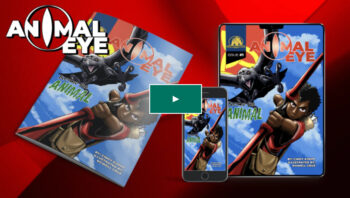
The opening image for Animal Eye on the Kickstarter page…mockups based on the front cover by Tabatha Catalan.
If you would like to find out more about how to do a KS campaign or a comic, please feel free to mention what you’d like to know in the comments below, and I will do all I can to help you. (Cindy and I actually have learned a thing or two as of now!)


































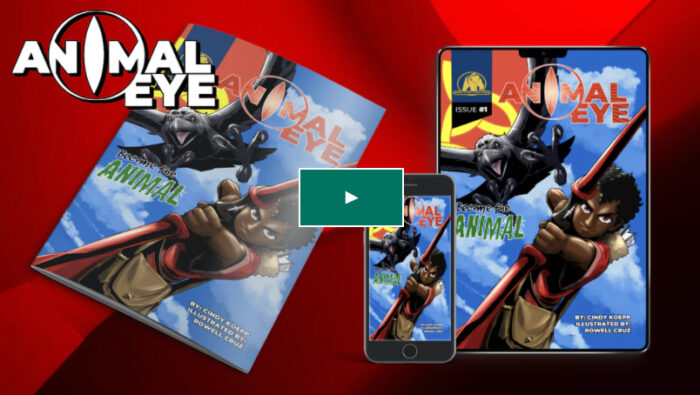
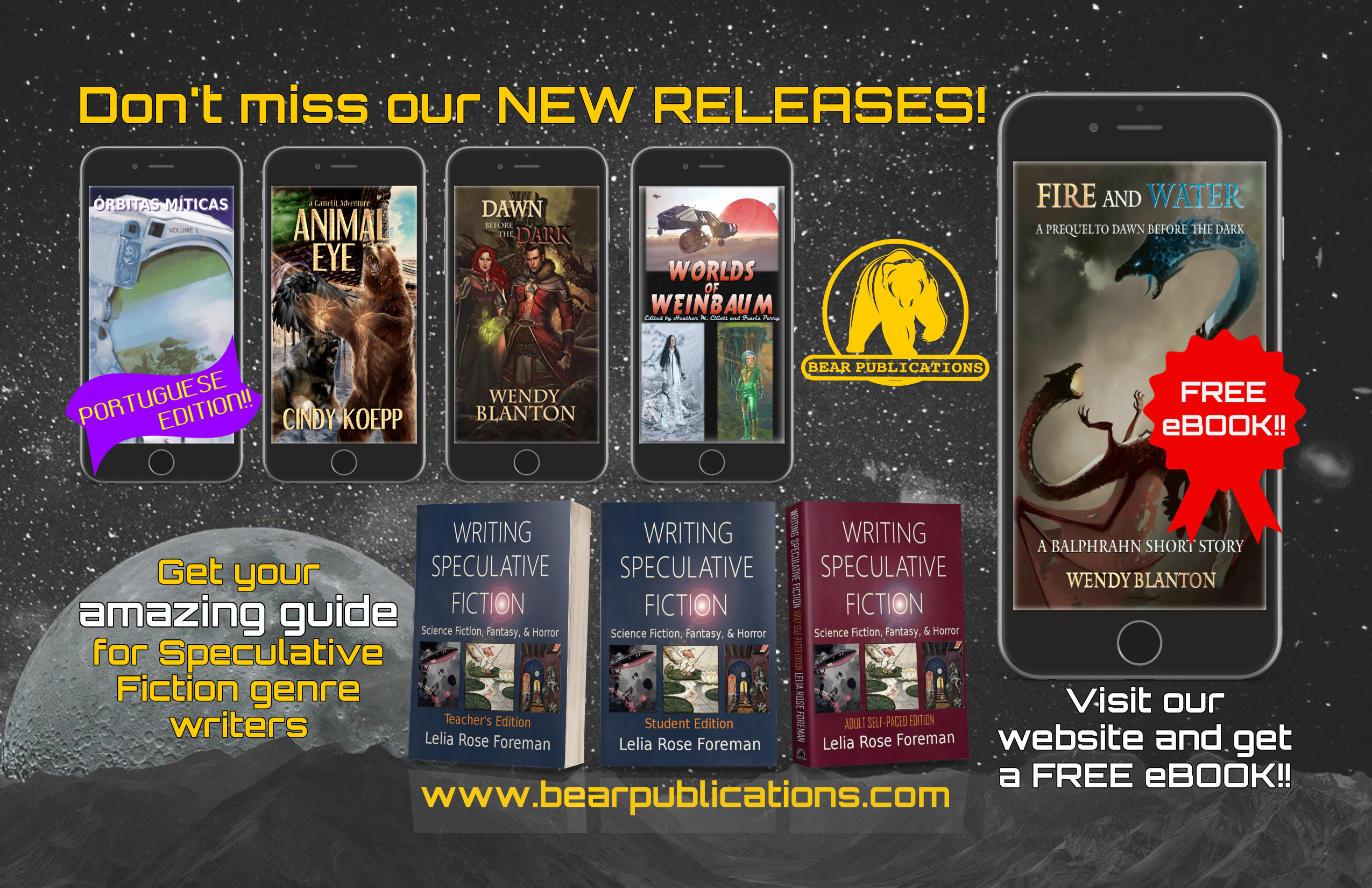








Hey, long time no see 🙂
I’ve been learning about/working with comics/animation for a long time, and have been hoping to get more people from Christian fiction circles interested in producing those mediums. So I’m glad I’m not the only one that sees the potential.
Just a few notes for anyone looking to start their own projects: There’s print on demand options available for comics as well, so technically Kickstarter isn’t necessary for everyone, even if they have a low budget. And of course someone could start out just selling digital copies. Once a publisher has enough of a backlist, they could also use a Netflix like model for their comics(services like Payhip have subscription billing).
As far as hiring artists on a low budget, there are payment models that could be applied instead of up front payment. In the audiobook industry, narrators can be paid upfront, OR will narrate in exchange for a percentage of royalties. Similarly, comic artists could either be paid upfront, or work for royalties instead. A hybrid option could also be arranged: a smaller upfront fee, with the rest of the payment consisting of a smaller percentage of royalties. It all just depends on the project, budget, and what the artist/publisher finds the most workable.
I’ll tentatively say that I might be interested in taking comic and animation work in the future, in between my own projects. I’ve already been doing a lot of work in terms of learning comic and animation publishing, so I have an understanding of more than just the art aspect. Or, I could answer questions pertaining to indie animation production. At a minimum, I could point you to some resources.
Anyway, good luck with the Kickstarter. Looks like you guys are making good progress on funding 🙂
So that’s what you’ve been doing!
This is, like, the weeb-iest response possible, but what helped me to understand the difference between making a comic/graphic novel/manga and something like storyboarding is reading Hayao Miyazaki’s manga for Nausicaa of the Valley of the Wind.
Because he draws like a storyboarder, not like a comic artist/mangaka. The best way I can explain it is when he wanted show Nausicaa riding off into the sky on her glider, he drew three or four panels of the figure receding into the background rather than one panel with, like, swoosh lines or something.
Also, if you feel the need to read manga to do research on the art of graphic storytelling, of course the weebs in the house will have plenty of recommendations for you.